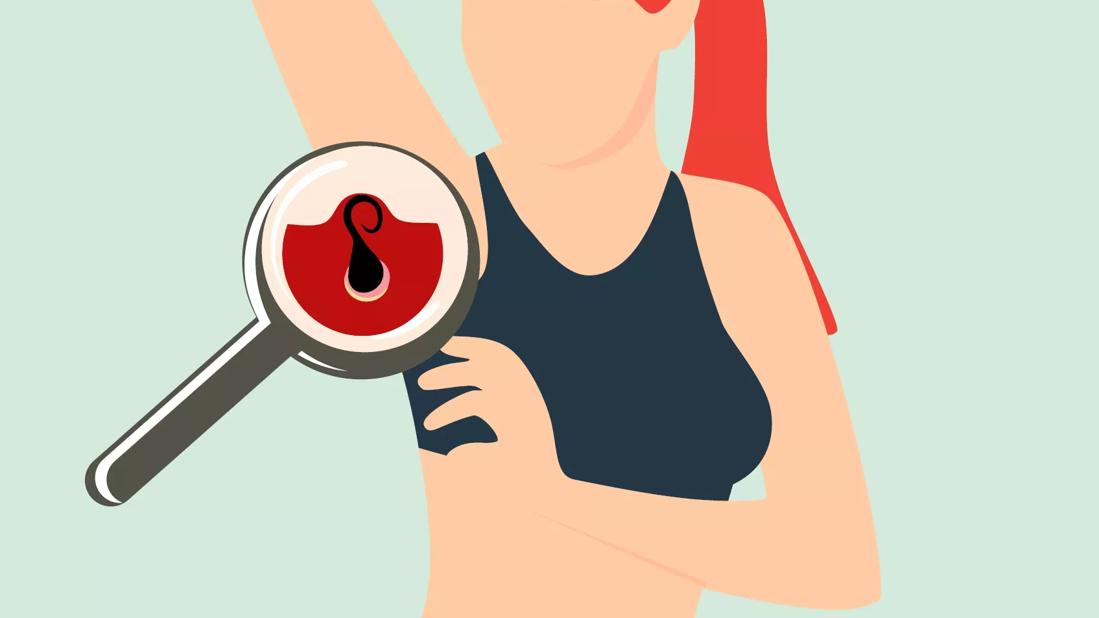Say bye-bye to shaving bumps with a few tricks

If you’re aiming for a smooth, hair-free look, ingrown hairs can ruin the effect. These unsightly bumps can be an annoying side effect of hair removal. The good news is ingrown hairs can be treated effectively at home.
Advertisement
Cleveland Clinic is a non-profit academic medical center. Advertising on our site helps support our mission. We do not endorse non-Cleveland Clinic products or services. Policy
Dermatologist Sherrie Bullard, MD, shares safe ways to get rid of ingrown hairs and how to prevent them from happening.
A hair becomes ingrown if it grows back into your skin while being outside of its hair follicle. The curlier the hair, the more likely it is to become ingrown. A hair can curve back into your skin as it grows out and become trapped under your skin. Friction is also a factor. So, wearing tight clothing such as leggings and jeans can contribute.
Ingrown hairs trigger inflammation as they enter your skin. “The immune system sees the ingrown hair as a foreign object — much like a splinter,” explains Dr. Bullard. “The skin turns red, and pustules develop. These are dead white blood cells. Release of chemicals from the white blood cells is what leads to the inflammation and itching.”
The good news is we aren’t helpless against ingrown hair breakouts. Some simple steps taken at home can eradicate these embarrassing bumps.
The market has exploded with skin care products with different ingredients to help with ingrown hairs. Major online beauty and drug stores carry these products.
“I would recommend this be the first place to go for help with ingrown hairs,” says Dr. Bullard.
Advertisement
These products range from serums to lotions, toners and pads that are gentle exfoliants. They’re a gentler alternative to traditional exfoliants.
One very useful product is adapalene gel, an over-the-counter retinoid medication. This medication can be applied to areas with ingrown hairs to help gently exfoliate until the ingrown hair appears at the surface of your skin. You can then carefully remove the hair with tweezers (see below).
Apply a warm, moist — not dripping — washcloth for 10 to 15 minutes, three or four times a day. Warm compresses soften your skin and may help ease inflammation and discomfort by allowing your skin to open and drain if there’s any pus present.
“Once the skin opens, if the ingrown hair is visible, it can be grasped carefully with clean angled tweezers and the hair pulled out,” advises Dr. Bullard. “Help the skin heal quickly by keeping the area clean and applying antibiotic ointment.”
If the hair is already visible and sticking out of your skin, you can attempt to tweeze the hair out.
Clean the area with warm, soapy water, clean your angled tweezers with alcohol and gently grasp the hair. If it’s difficult to see the area, use extra lighting like an LED ring light and a magnifying mirror. This will allow you to grasp only the hair and avoid damaging your skin. Resist the urge to squeeze.
If the hair is completely under your skin, avoid the temptation to poke the area with a sharp object and dig out the hair. This can lead to infection and scarring. Please see a healthcare professional for help in this situation.
Exfoliation should be approached carefully, as it causes inflammation, which leads to hyperpigmentation and may not be very helpful in resolving ingrown hairs.
What if you’ve tried home remedies, and the ingrown hair just won’t go away? The ingrown hair may eventually make its way out of your skin. But this process can take time. There are also situations where the hair will continue growing under your skin. In this case, Dr. Bullard suggests seeing a dermatologist.
There’s a chance that an ingrown hair can become infected. Be on the lookout for these signs:
If you notice one or more of these symptoms, see a physician or health professional for help as soon as possible.
You can’t always prevent ingrown hairs, but you can take steps to lower the chances of them developing.
Advertisement
If ingrown hairs won’t take a hike, you may need to forgo shaving, waxing or tweezing that area. Consider alternative hair removal options, like laser hair removal. This method targets the hair follicle, and it’s usually permanent. And because the hair doesn’t grow back after treatment, you won’t have to worry about ingrown hairs.
“Laser hair removal is safe and effective on all skin types,” says Dr. Bullard. “If you decide to pursue this method, talk to a doctor who has experience performing this treatment.”
Ingrown hairs can be aggravating, but treat your skin gently. Trying to extract an ingrown hair that isn’t ready can lead to permanent scarring and discoloration.
If these at-home remedies aren’t working, step away from the tweezers and call your doctor. A medical professional can treat ingrown hairs and help you prevent them in the future.
Advertisement
Learn more about our editorial process.
Advertisement

Scalp cancers can occur because of long-term sun exposure

Soften your skin with warm water and shaving cream before shaving with the grain of the hair

Age is the most likely reason for typical graying, but premature graying may be caused by stress, diet, smoking or autoimmune disease

Focus on nutrition, gentle styling habits and adapting to your hair type

Eating whole grains, salmon, fruits and vegetables can help you achieve longer, healthier locks

Your genes, ethnicity, diet and stress levels may all affect your facial hair

Your hair removal routine will depend on your pain tolerance, budget and skin sensitivities

Prepping the area, exfoliating beforehand and communicating with your esthetician will help give you the best (and least painful) results

Leg-related symptoms indicate DVT, while chest symptoms point to a pulmonary embolism

There are many different ways to love someone and yourself

Looking down at your smartphone or computer screen can stress muscles in your neck, shoulders and back